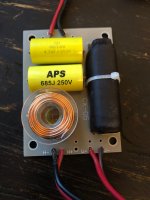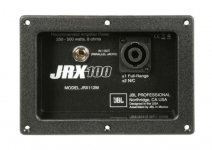Hello good people,
I'm relatively inexperienced at this stuff and a little confused by what i'm running up against. My buddy gave me a JBL floor monitor which was not working. I pulled it apart, the woofer worked fine if i used a tone generator on it, the horn seemed to work fine similarly, so i assumed the two way crossover had an issue. I replaced it with one from amazon, and had the same issue, but i could hear that there was audio coming down that line with an induction wand. I tried several other speakers that should have been able to replicate high end frequencies and got nothing. I then took the leads from the x-over to the woofer and put them to the horn and it made high end noise. At this point i assumed i got a DOA crossover and had amazon replace it. New crossover is having the same issue. If i run full range to the horn, it functions ( i know not to leave it like that) Anyone know what might be going on here?
I did look through the forums for a similar issue, but didn't find one. Apologies if i missed it.
Thanks
telfer
Speaker: JBL JRX100
horn: JBL2412h-1
Woofer: JBL M112-8 (8 Ohms)
original crossover jrx112M
new crossover(s) EMB CX-5
I'm relatively inexperienced at this stuff and a little confused by what i'm running up against. My buddy gave me a JBL floor monitor which was not working. I pulled it apart, the woofer worked fine if i used a tone generator on it, the horn seemed to work fine similarly, so i assumed the two way crossover had an issue. I replaced it with one from amazon, and had the same issue, but i could hear that there was audio coming down that line with an induction wand. I tried several other speakers that should have been able to replicate high end frequencies and got nothing. I then took the leads from the x-over to the woofer and put them to the horn and it made high end noise. At this point i assumed i got a DOA crossover and had amazon replace it. New crossover is having the same issue. If i run full range to the horn, it functions ( i know not to leave it like that) Anyone know what might be going on here?
I did look through the forums for a similar issue, but didn't find one. Apologies if i missed it.
Thanks
telfer
Speaker: JBL JRX100
horn: JBL2412h-1
Woofer: JBL M112-8 (8 Ohms)
original crossover jrx112M
new crossover(s) EMB CX-5
Post clear photos of everything. Look at the 1/4" phone jack, fuses, etc.
Use an ohm meter to trace out the wiring from the rear panel inputs to the woofer terminals.
Since both drivers don't work, it must be one of the connectors on the back panel that is
either shorting or open. Most likely to be a bad solder joint or crimp, or a broken contact.
Here is the schematic, not much to it.
https://www.fullcompass.com/common/files/2205-JRX112MSpecs.pdf
Use an ohm meter to trace out the wiring from the rear panel inputs to the woofer terminals.
Since both drivers don't work, it must be one of the connectors on the back panel that is
either shorting or open. Most likely to be a bad solder joint or crimp, or a broken contact.
Here is the schematic, not much to it.
https://www.fullcompass.com/common/files/2205-JRX112MSpecs.pdf
Last edited:
@Rayma Sorry, i guess i was unclear, the woofer works fine now. I think one of the spade connectors was loose initially, i think.
@AllenB- i'm not great on the component level, but the circuits are supposed to be very simple, right? A coil, a cap, etc. One input two outputs, not rocket surgery, but so after you asked i started looking at it. The horn output looks like the two terminals are just shorted together to me? I checked them with a multimeter and there's continuity with nothing hooked up, which is not the case with the woofer output or the outputs from the old crossover. Did i just buy some garbage units with mis-printed circuit boards?. The bottom right two terminals when looking at the back of the circuit are the horn output terminals.
Log into Facebook
An externally hosted image should be here but it was not working when we last tested it.
Log into Facebook
That doesn't sound good at all...
Rocket surgery, well... but anyway it could have been a piezo, so..
By the way, not all of us do Facebook. Your image isn't showing.
Rocket surgery, well... but anyway it could have been a piezo, so..
By the way, not all of us do Facebook. Your image isn't showing.
@Rayma Sorry, i guess i was unclear, the woofer works fine now. I think one of the spade
connectors was loose initially, i think.
Then check the 2.7uF tweeter capacitor, it could be open or have a bad connection.
By the way, not all of us do Facebook.
Nobody should use Facebook.
Zuck: Yeah so if you ever need info about anyone at Harvard
Zuck: Just ask
Zuck: I have over 4,000 emails, pictures, addresses, SNS
[Redacted Friend's Name]: What? How'd you manage that one?
Zuck: People just submitted it.
Zuck: I don't know why.
Zuck: They "trust me"
Zuck: Dumb f**ks
Last edited:
thanks for the tutorial on how to upload images. The request for a URL definitely threw me.
But now that you can see the images, can anyone tell me if the horn leads should have continuity between them? The woofer leads don't.
But now that you can see the images, can anyone tell me if the horn leads should have continuity between them? The woofer leads don't.
Attachments
Looks as if the red horn wire is soldered in the 2nd black wire hole, instead of to the hole marked H+. Human error.
Looks as if the red horn wire is soldered in the 2nd black wire hole, instead of to the hole marked H+. Human error.
There are crossover types which actually need a reverse polarity of one (or more) driver(s). The JBL JRX112M isn't one of them though. And that would not prevent the drivers from playing anyway.
rayma posted the PDF which contains the solution, you can see the culprit in this picture probably a bit better:
The connectors are a Speakon and a 6,3mm jack. The Speakon uses only 1+ and 1-, the pins 2+ and 2- are not connected (nc), just as the text on the terminal says. So if you are using a Speakon cable, that's the problem. Either re-solder the Plug of the cable, the Speakon plug of the speaker or (if it's a 3/4 wire cable), use the other wires/pins. If you are using 1+/- already, maybe someone changed the pins in the plug for some reason.
The 6,3mm jack could also be a problem but that's even easier to solve, use a multimeter/ohm meter and check for a short in the plugs or cable.
One more possible error source: There could be a defect cable within the box, between the terminals or the crossover and the terminal.
May be best to begin with the short on the board?There are crossover types which actually need a reverse polarity
I sure as **** do not need Facebook. Thank you for that post rayma. Pretty pathetic that people trust Facebook, get a clue.
May be best to begin with the short on the board?
Good idea but I did write to check them? Besides that, the xo is usually screwed to the back of the terminal, so not to check them is double the work and I assumed he goes over the posts and why repeat what's already said?
The driver is shorted but that is of no consequence because the crossover's tweeter output is an open circuit so nothing is driving the short.it's pretty clear the tweeter leads are sharing the same copper land how is that not a short?
- Home
- Live Sound
- PA Systems
- horn vs xover issue


